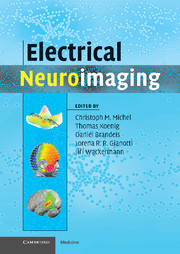Book contents
- Frontmatter
- Contents
- List of contributors
- Preface
- 1 From neuronal activity to scalp potential fields
- 2 Scalp field maps and their characterization
- 3 Imaging the electric neuronal generators of EEG/MEG
- 4 Data acquisition and pre-processing standards for electrical neuroimaging
- 5 Overview of analytical approaches
- 6 Electrical neuroimaging in the time domain
- 7 Multichannel frequency and time-frequency analysis
- 8 Statistical analysis of multichannel scalp field data
- 9 State space representation and global descriptors of brain electrical activity
- 10 Integration of electrical neuroimaging with other functional imaging methods
- Index
- References
7 - Multichannel frequency and time-frequency analysis
Published online by Cambridge University Press: 15 December 2009
- Frontmatter
- Contents
- List of contributors
- Preface
- 1 From neuronal activity to scalp potential fields
- 2 Scalp field maps and their characterization
- 3 Imaging the electric neuronal generators of EEG/MEG
- 4 Data acquisition and pre-processing standards for electrical neuroimaging
- 5 Overview of analytical approaches
- 6 Electrical neuroimaging in the time domain
- 7 Multichannel frequency and time-frequency analysis
- 8 Statistical analysis of multichannel scalp field data
- 9 State space representation and global descriptors of brain electrical activity
- 10 Integration of electrical neuroimaging with other functional imaging methods
- Index
- References
Summary
Introduction and overview
Time series of EEG scalp potential differences typically appear to be composed of oscillations at various frequencies. Although the amplitude and spatial distributions of these oscillations may fluctuate in time, the quantification of these oscillations as a function of frequency and location (i.e. the multichannel spectral analysis of the EEG) is very reproducible within and across subjects and systematically varies depending on a series of physiologically interesting factors. To mention a few examples, EEG spectral analysis has been successfully employed to characterize a subject's age, state of arousal, the presence of neurological or psychiatric disorders, drugs or task demand as systematic deviations of spectral power from a norm.
In the present chapter, we will outline the possibilities of quantifying EEG oscillations with a special emphasis on those aspects that are specific for multichannel EEG. First, a methodological primer delineates the interdependencies among spectral amplitude, phase and recording montage. In addition, it also delineates what scalp signals we expect from one or several known oscillating sources in the brain. Next, we describe the currently employed analysis strategies: starting from the classic EEG spectral power mapping of measured EEG, we proceed to methods that take into account the relations of amplitude and phase between the different electrodes, which is an essential prerequisite for discussing the results in terms of sources and interactions of brain regions. Finally, we delineate possible methods for custom-tailored quantitative analyses of multichannel EEG oscillations and source localization in the frequency domain.
- Type
- Chapter
- Information
- Electrical Neuroimaging , pp. 145 - 168Publisher: Cambridge University PressPrint publication year: 2009
References
- 6
- Cited by



